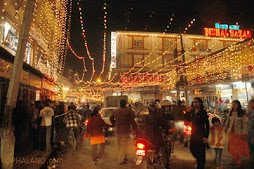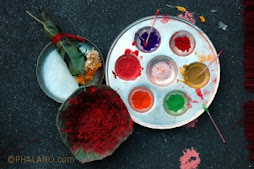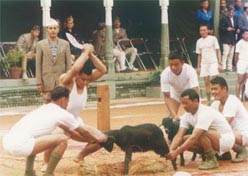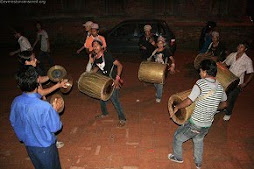I guess, it was “written” that I would become a professor of tourism, specializing on management of natural resources and tourism impacts in remote areas. I find it rather interesting how early encounters with wildlife shape future careers. The curiosity about places other than my own hometown planted in me a seed for my future adventures, some of which were utterly reckless. Encounters with wildlife also started with a bizarre set of events. As I wrote in a previous posting, I am really afraid of snakes. I am curious about snakes, thrilled to see it crawling (this makes hair on my spine stand up!), but will not go closer even if it is dead. My mom tells me that when I was a two-month old baby, she had taken me to Khajuri where all kinds of venomous snakes crawled around. King Cobras were common; I am fortunate not to have seen it in the wild. I have seen big Dhamans (Ptyas mucosus) on the banks of Devata Pokhari. So my mom puts me on bed for an afternoon nap. My grandparent’s house in Khajuri consisted of two modest buildings. The walls were made of a reed-mud combination and the roof had cylindrical-shaped tiles. The two buildings were separated by a courtyard in the middle and gardens on the sides. It was a custom in the village to spend the afternoon mostly in the verandah or the courtyard because it would get terribly hot during summer. Anyway, I was sleeping on a make-shift bed on the ground. All of a sudden, there was a big snake underneath my bed. Everybody was panicking and did not know what to do, no one dared to come close to me. So there I was surrounded by a big snake, and I could do nothing about it (my mom told me that I was sound asleep). Fortunately, the snake slithered away after sometime and everybody rejoiced that nothing bad happened to me. May be snake phobia is in my genes, as I know that my mom and I react exactly the same way whenever we see a snake.
Thus, encounters with wildlife were something that came natural to me. Chitwan in the late 60s and early 70s was pretty much a wild place. People had this notion that there were more wild things in Chitwan than people. Our house in Chitwan back then was very rudimentary, made mostly of wood and thatch grasses. This was a temporary house as most of our family members (except my uncle) lived in Kathmandu. My dad was temporarily assigned to Chitwan. The year must have been 1973. I remember when I was 11 we had a bad incident in our homestead in Chitwan. Back then, we used to keep many chickens (around 200) and we had two pairs of goats, one pair was skinny than the other. One night, my dad saw a pair of glowing eyes in the dark as he went out to relieve himself. He did not know what exactly the animal was but the following morning we found that a pair of goats was missing from the corral. The whole family went out to search for the missing goats, and lo and behold!, we found the mother goat lying dead in the field. She had been blood-sucked dry and there was a fatal mark around her neck. The kid goat was nowhere to be found. Later in the afternoon, my uncle found its head at the edge of our field (the edge marks the boundaries between our land and the Barandabar forest). Villagers gathered in our house concluded that it must have been the clouded leopard (Neofelis nebulosa) who had snatched away the goats. There were also rumours about witchcraft, but it seemed to us that the culprit in this case was not a poor woman in the village but a nasty leopard. The leopard must have been really smart as he chose the two healthy (fat) ones and not the skinny ones; they were left untouched, they seemed very sacred though. This was my earliest exposure to human-wildlife conflict in Chitwan, a topic which would become one of my major research themes in my future academic career. I would come back to this issue ten years later as an academic researcher.
Monday, August 10, 2009
Subscribe to:
Post Comments (Atom)












































The picture "the royal hunt" in your blog reminds me something occuring in Khao Yai National Park. Many of park official told me that long long time ago, tigers were easily found in the park and they were illegally hunted and sold to rich person. Like a social norm, the rich person wanted to have tiger skin in their houses to show social status or how rich they were.....
ReplyDeleteI'm snakephobia too. I don't know why.
I was lucky. I found only one snake in Khao Yai National Park during my field trip.
It's a snapshot of natural beauty and cultural heritage of Nepal. The narrative of the rich Nepali culture along the line of the Dashain festival appeals to every single connoisseur. An aesthetically plesaing narrative comginining myth and history, nature and culture, and tradition and modernity!!!
ReplyDeleteThe image of "Street bands marching past neighborhood" demonstrates the country folk's love for art as a means to connect them to the divine. Celebration of life amid rituals!!!
Dhruba